An elegant past: the Sussex Croquet Ball
The first Sussex County Croquet Club was founded in 1869 and held its meetings on the Eastern Lawn of Brighton Pavilion. It seems this was very much a society pastime and so, not only were competitions held regularly, but also an annual croquet ball.
The Brighton Croquet Ball seems to have first taken place in 1871, although no report is available. That it took place is alluded to in reports in 1872 which refer to "the second annual ball". We have reports for subsequent balls, up until 1877. It may have continued in later years but 1877 saw the rise of lawn tennis and the slow demise of croquet clubs for the next 20 years so it perhaps unlikely. Later balls have only a passing reference in the papers of the time, unlike the fullsome report of the first few.
The 1872 ball was, it seems, keenly anticipated. The Morning Post had it thus:
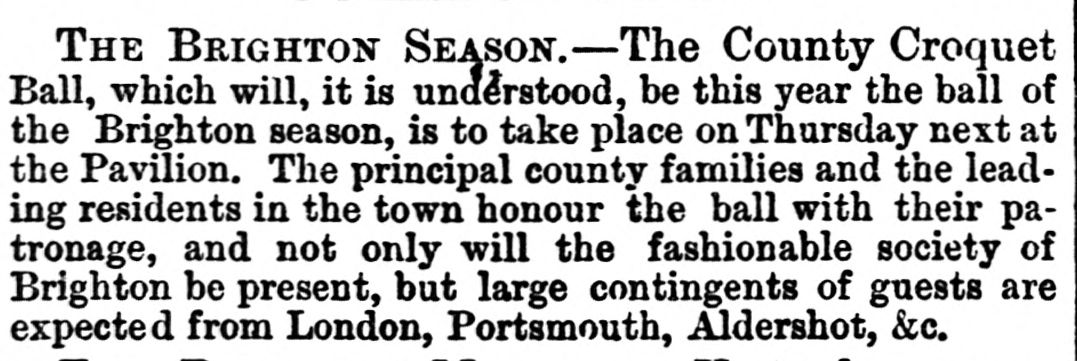
The planning must have been meticulous.
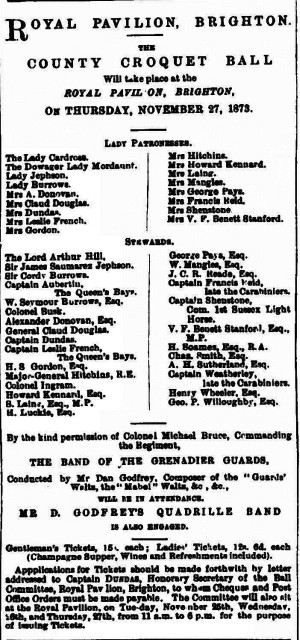 Advertising like this appeared in the local press (and perhaps more widely) and there was a large organisation of patronesses and stewards to manage the event.This one from 1873 lists 4 ladies of various ranks, two baronets, a Major General, two Colonels and six captains amongst its management, amongst them the indefatigable Captain Dundas.
Advertising like this appeared in the local press (and perhaps more widely) and there was a large organisation of patronesses and stewards to manage the event.This one from 1873 lists 4 ladies of various ranks, two baronets, a Major General, two Colonels and six captains amongst its management, amongst them the indefatigable Captain Dundas.
Captain Dundas seems to have been the organising force behind the balls over this period. Captain Dundas (1828 - 1920) was born in Bengal into a ranking military family and lived at the time in Bloomsbury Place, Brighton. He was a member of the croquet club and its first Hon. Secretary; he seems to have been an enthusiastic player though perhaps not of the first rank.
Captain Dundas resigned as Hon Secretary in 1871 when Mr Henry Griffith took over. Perhaps he was more interested in organising the croquet balls by this time. His resignation was reported in the local newspaper with a further (and more interesting as events proved) fact:
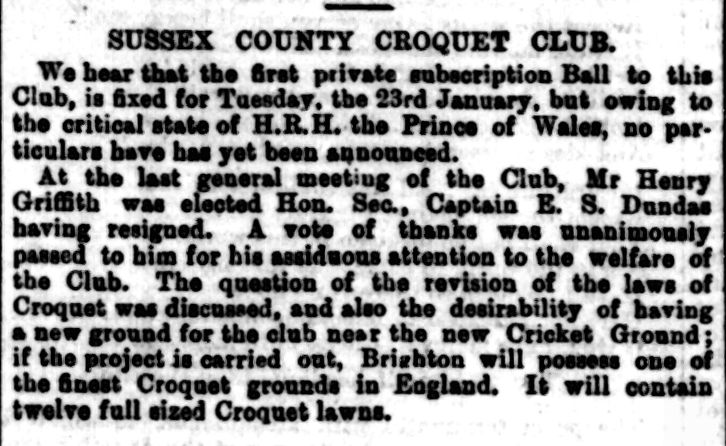
From this it is clear the move from Brighton to Hove or beyond and the general size of the future club was already being considered 30 years before it finally happened. Were any of the founding members in 1900 also present in 1871?
So what were these croquet balls like? Well received at any rate:
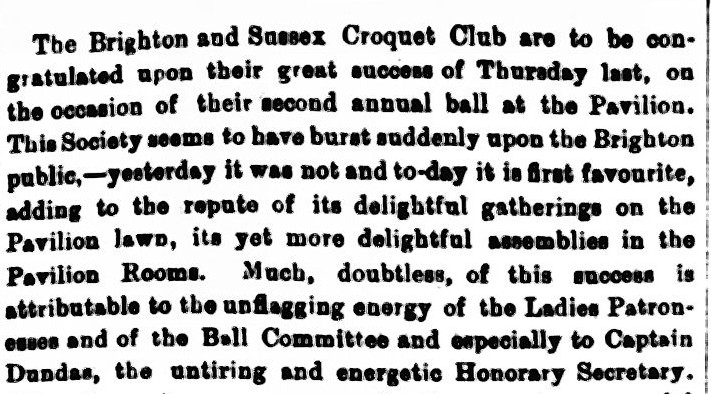
The Croquet Ball was the height of the season in the Brighton of its time. Its success must be measured by the attendance which was extraordinary. From a number of around 100 guests for the first ball in 1871 to 450 in 1872, 750 guests were reported in 1874, and 800 in 1877.
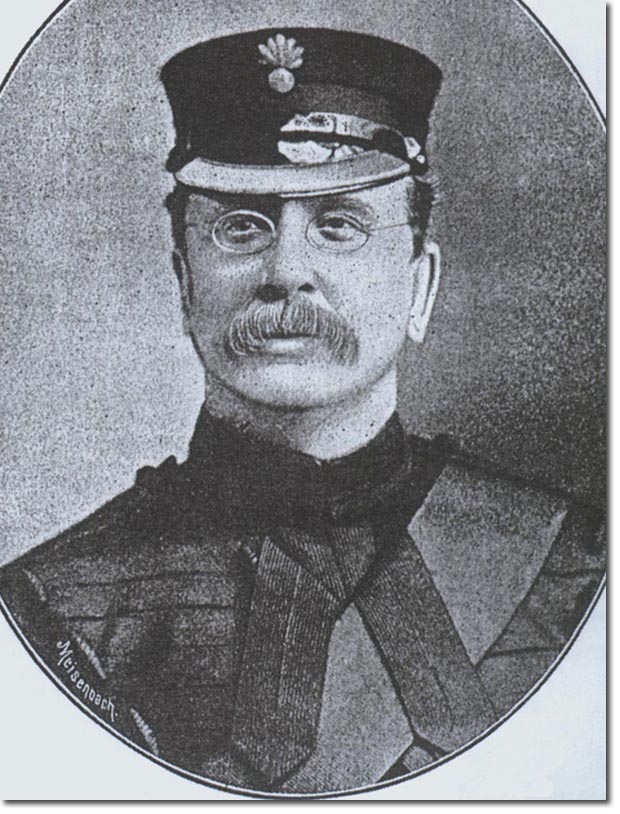 A significant feature of these balls was the music. On each occasion this was provided by the Band of the Grenadier Guards, supported by a smaller group (from the same players perhaps). The conductor was the famous Mr Dan Godfrey, Bandmaster of the Grenadiers and composer of several well know walzes of the time. To secure their services for the Ball must have been a great coup and perhaps contributed to the number of guests present. (picture source: britishempire.co.uk)
A significant feature of these balls was the music. On each occasion this was provided by the Band of the Grenadier Guards, supported by a smaller group (from the same players perhaps). The conductor was the famous Mr Dan Godfrey, Bandmaster of the Grenadiers and composer of several well know walzes of the time. To secure their services for the Ball must have been a great coup and perhaps contributed to the number of guests present. (picture source: britishempire.co.uk)
There were reports in a number of national papers but for a full report of just one, the Croquet Ball of 1873, we go to the Brighton Gazette. To save your eyes it is not shown as printed but in clear text. (Brighton Gazette 29 November 1873)
a goodly number of the leaders and followers of fashion in one of the most fashionable towns in the world. Well, it is the Croquet Ball! The Croquet Ball! But what of Croquet, and what can that simple summer game have to do with this fascinating entertainment? All that is commonly known of Croquet, is that it is an innocent recreation for young people especially, and offers advantages of companionship and association often tending to unions of a closer and more binding description. Croquet, itself, is an invention of yesterday, what, then, is there in Croquet to create such an interest as to bring together what will doubtless prove the most brilliant assembly of the season. Well, this was given under the auspices of a Croquet Club, and it is promoted by the Croquet players of Brighton. Croquet has emerged from its state of primitive simplicity ; it has become a science, and has its numerous votaries of both sexes, especially amongst our fashionable visitors. The comparatively few people who represented the new Croquet Club in 1871, have grown into a magnificent circle of five hundred in the short space of less than two years. Part of this is doubtless due to the popularity of the recreation, but a great deal more is unquestionably due to the able management. Most societies depend for their success or failure upon that all-important personage, the Hon. Sec., and, in this instance, success is chiefly due to the exertions of Captain Dundas, who has, from the commencement of the Club's existence, we believe, filled most efficiently that very important office. The establishment of the Croquet Ball was an excellent idea, serving as it does to keep up in the cold winter, when out-door recreations are few, the friendly associations began in the sweet summer time, under the shade of leafy trees, now gaunt, bare and black, to the accompaniment of the tuneful click of the croquet ball. The ball is still the attraction, but it is a ball of another kind. Either croquet must have become immensely popular, or the Hon. Secretary is very popular, perhaps both, for it is almost impossible to imagine an entertainment more successful in every way than the Croquet Ball of Thursday night.
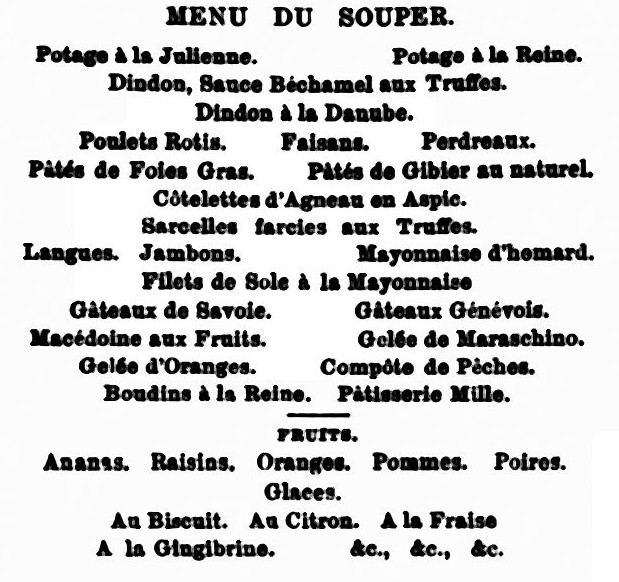
(To translate roughly: vegetable soup, thick chicken soup, turkey in a truffled bechemel sauce, roast chicken, pheasant and partridge, duck liver and boar patés, lamb cutlets in aspic, teal with truffle stuffing, tongue - ham - lobster mayonaise, fillet of sole mayonaise. Two types of light cake, fruit salad, jellies, peach compote, a chicken and mushroom sausage (why here?), more patisserie. Various fruits and ice creams.)
We don't know when the last croquet ball took place but 1877 is the last for which there is a reference in available newspaper archives. Tennis was taking over from croquet, the club closed in 1884 so perhaps that was the end of an era.
